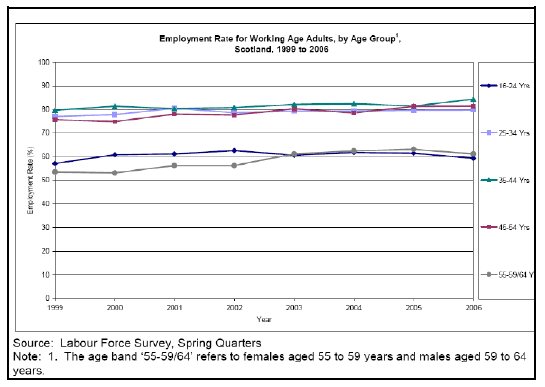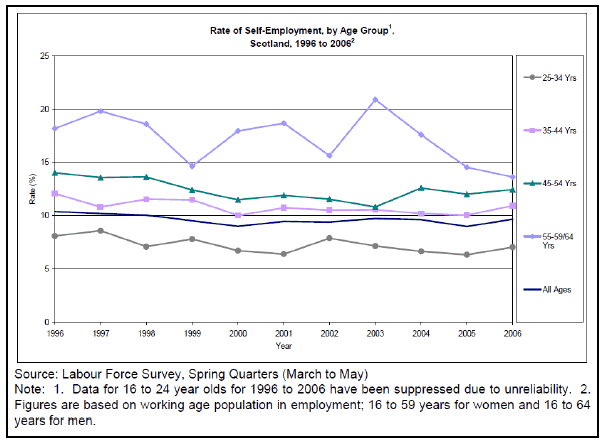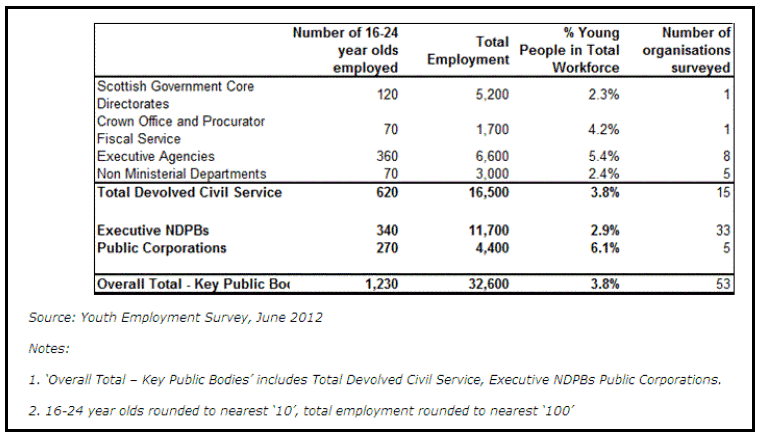Scottish Government Equality Outcomes: Age Evidence Review
This evidence review was prepared to support the production of the Scottish Government's Equality Outcomes, with regard to age.
4 Employment
4.1 This section examines what is known about the employment rate, the unemployment rate, underemployment, economic inactivity, self-employment, business ownership, employment by sector, occupational skills, modern apprenticeships, and pay gaps.
Employment rate
4.2 The EHRC Review of Research[12] gives an overview of employment trends in Scotland from 1991-2006 (see Figure 4). Employment rates increased between 1999 and 2006, most markedly for the 55 to 59/64 age band. These changes represent a rise of almost 8% among this age group, while other age groups saw only marginal rises in employment during that period. The recent increase in employment among older workers is likely to have been driven by increases in older women's employment - rising from 54% in 1984 to 67% in 2005. This increase is most strongly associated with the ageing of birth cohorts of women who had higher employment rates earlier in life than previous cohorts.
Figure 4: Employment rate by age group, 1999-2006

4.3 In recent years in Scotland there have been the following trends in employment rate for different age groups:
4.4 16-24 years: the proportion of this age group in employment decreased between 2008 and 2011, from 60.8% in 2008, to 55.6% in 2010 and 54.6% in 2011[13]. Importantly, almost all of the decrease in the 16-24 year old employment level was accounted for by those not in full-time education (down 39,100 since 2008). This decrease was a result of decreases in employment in medium-low skill occupations (down 24,200) and medium-high skill occupations[ii] (down 19,700). However, between May-Jul 2011 and May-Jul 2012 the non-seasonally adjusted employment rate for the 16-24 age group increased by 1.0 percentage points (328,000)[14]. Compared to other key age groups, 16-24 year olds saw the largest increase in employment over the year.
4.5 25-34 years: the percentage in employment in this age group had decreased from 81.2% in 2008 to 77.9% in 2010. However, it increased by 1.1 percentage points to 79.0% in 2011[15].
4.6 35-49 years: between 2008 and 2011, the percentage in employment in this age group has decreased from 83.1% in 2008 to 81.5% in 2010, and to 81.1% in 2011[16].
4.7 50-64 years: between 2008 and 2011, the percentage in employment in this age group decreased from 65.2% in 2008 to 64.1% in 2010, and to 63.7% in 2011[17].
Unemployment rate
4.8 In 29 of the last 36 periods[iii] there has been an increase in the youth unemployment rate over the year. This indicates an increasing underlying trend in youth unemployment in Scotland in recent years. Compared to other key age groups, 16-24 year olds saw the largest increase in unemployment rates over the year (up 2.8 percentage points to 105,000) followed by the 35-49 year olds age group (up 0.6 percentage points)[18].
4.9 It is important to note that in 2012, only 23% of 16-24 year olds who were unemployed in Scotland were in full time education, compared to the UK-wide figure of 30%[19].
Underemployment
4.10 Underemployment includes all employed persons aged 16 and over who are willing to work additional hours. Underemployment rates vary across age-groups[20]:
- Those aged 16-24 had the highest underemployment rate in 2011 at 14.1%, an underemployment level of 46,500. The high rate for this group may be indicative of the higher percentage of those employed 16-24 year olds in part-time employment (about 43% compared to about 26% for those aged 16-64).
- Those aged 25-34 and 35-49 had similar underemployment rates in 2011, at 9.0% and 7.6% respectively.
- 50-64 year olds had the lowest underemployment rate at 6.1% in 2011. This group has seen the highest increase in level since 2004, having increased by 59% from 25,300 in 2004.
Inactivity
4.11 The data in Revisiting Resilience[21] show that Scotland's youth inactivity rate (Apr-Jun 2011) was 24.2% (118,000 individuals) which is lower than the UK, where the rate was 30.2%. Over the year the rate in Scotland decreased by 0.2 percentage points. A large number of economically inactive 18-24 year olds will be students.
4.12 The data contained in Local Area Labour Markets in Scotland[22] show that between 2005 and 2007 there was a significant reduction in the size of the NEET group (not in education, employment or training),a decrease of 7,000 to 29,000 (2.9 percentage points). This was followed by an increase of 7,000 (2.7 percentage points) between 2007 and 2010. Between 2010 and 2011 the proportion of 16 to 19 year olds estimated to be NEET decreased by 1.5 percentage points to 12.2% with the level reducing to 31,000.[23]
4.13 The reason for not working is closely related to age. For young people, the primary reason is participation in education; later in life the main reason is looking after family; and for people aged 50 to State Pension Age the main reasons are long-term sickness and early retirement[24].
4.14 The number of people aged 25-49 in Scotland who have never worked has risen by just under 54% since 2004, from 33,500 to 51,600 in 2011, whereas the number of people aged 50 and over who have never worked has decreased by just under 33% from 32,900 in 2004 to 22,100 in 2011[25].
4.15 Retired people accounted for 18.3% of the inactive population aged 16-64 in Scotland in 2011[26].
Self-employment
4.16 Self-employment rates rise as people age[27]. The self-employment rate for Scotland as a whole in 2011 was 11.5%. Although those aged 65 and over made up a small share of all those self employed (6.4%), those aged 65 and over had the highest self-employment rate (32.5%)[28].
4.17 The High-level summary of equality statistics[29] plots rates of self-employment by (working) age group - see Figure 5. The rate is highest for adults aged 55 to pensionable age (14% of adults in this age group) and lowest for those aged 25-30 years (7% of adults in this age group). In general, rates of self-employment have tended to fluctuate year on year for each age group but do appear to be decreasing for those aged 55 to pensionable age in recent years, following a peak in 2003 (21% of adults in this age group).
Figure 5: Self-Employment by Age Group, Scotland, 1996 to 2006

Business ownership
4.18 In 2007/08, the proportions of small to medium-sized enterprise owners and co-owners in Scotland fell in the following age groups: 35-44 (20%), 45-54 (35%) and 55-64 (28%). The proportions in younger and older cohorts were much smaller: just 10% were aged under 35, and 7% were aged 65 and over[30].
Employment by sector
4.19 The statistics from the Annual Population Survey 2011[31] show that since the start of the recession in 2008, there have been decreases in both public sector and private sector employment in the 16-24 and 35-49 age groups. The 16-24 age group experienced a greater fall in private sector employment (down by 30,000) compared to public sector employment (down by 10,100) while the 35-49 age group experienced a greater fall in public sector employment (down by 34,600) than private sector employment (down by 26,600). In contrast, the 25-34, 50-64 and 65+ age groups saw increases in both public and private sector employment. In the public sector, there were increases of 3,800, 6,300 and 3,200 respectively, while in the private sector, the increases were higher for all three age groups at 10,400, 7,100 and 3,700 respectively.
4.20 Scotland's Public Sector Employment statistics for the first quarter of 2012[32] (Figure 6) show that:
- There were 1,230 young people (aged 16 to 24 years) working in Scotland's key public bodies, representing 3.8% of total employment (see Figure 6). Of these, 550 were males (44%) and 690 females (56%). The majority were working in full-time (84%), permanent (69%) posts.
- There were 120 young people working in the Scottish Government Core Directorates as at the first quarter of 2012, representing 2.3% of the total workforce.
- Public Corporations and Executive Agencies had the highest proportion of young people within their workforce, at 6.1% and 5.4% respectively.
Figure 6: Youth Employment in Scotland's Key Public Bodies, Headcount, Q1 2012

Occupational skills
4.21 The occupational skill distribution is broadly similar across the key age groups, with the majority (approximately two thirds) of employees in medium-low and medium high skilled occupations and a minority (around 10%) in low skilled occupations[iv]. However, the distribution is different for the 16-24 year old age group which has a relatively lower percentage of employees in high skill jobs (6%) and a relatively higher percentage in low skill (25%) and medium-low skill (45%).The different distribution for 16-24 year olds may be explained by the fact that it takes time to acquire the relevant qualifications and experience required for high skill occupations[33].
Modern Apprenticeships
4.22 Young people figure prominently in modern apprenticeship schemes. 54% of new starts to Modern Apprenticeships are aged 16-19, and of all those in training following a Modern Apprenticeship 66% are 16-19 years old[34].
Pay gaps
4.23 Low pay (less than £7 per hour) is most prevalent among workers aged 21 and under: they account for one fifth of all low-paid workers on adult rates[35].
Contact
Email: Social Research
There is a problem
Thanks for your feedback